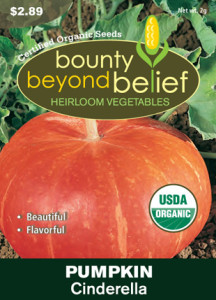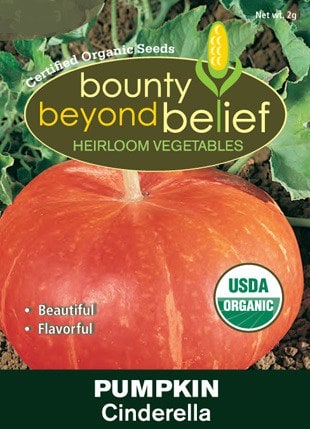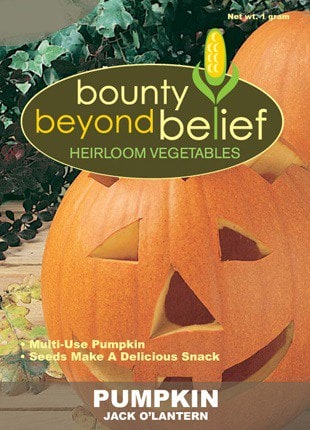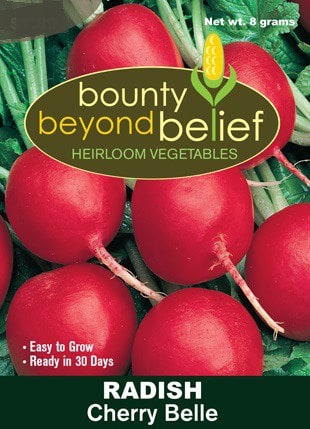Description
Cinderella Pumpkin, Cucurbita maxima, is an antique French heirloom, popular in the 1800s that originated in South America. Not really a true pumpkin, it has flattened shiny red-orange fruits with narrow deep ribbed sections and rough bumpy skin. These can grow up to 40 lbs. and are beautiful and decorative. The flesh is flavorful and great for cooking and pies. The large seeds are good for toasting.
- The Rouge Vif D’Etampe (“vivid red”) pumpkin is rumored to be the original inspiration for the carriage in the classic Disney film Cinderella. It has been said that animators used the variety in the studio as a muse and sketched multiple variations of the pumpkin before the final version of the carriage was created. After the release of the film, the Rouge Vif D’Etampe pumpkin earned a new name, the Cinderella pumpkin, and this is the name most commonly used in the United States today.
- In 1883, W. Atlee Burpee purchased the seeds and introduced the variety to the United States.
- The sweet, moist flesh of Cinderella pumpkins makes them an excellent choice for sweet preparations such as pies, breads, muffins, and cakes.
- They are also excellent in soups, stews, and casseroles.
- Fruits will last 3-5 months when stored in a cool, dark place.
- Recipes:

Cinderella Pumpkin Bowl with Vegetables & Sausage
Cinderella Pumpkin Soup
Planting tips for Cinderella Pumpkin:
Pumpkins are friends with corn, melon, and squash. You can also plant marigolds, nasturtium, and oregano with your pumpkins to help deter pests. The plants are very sensitive to frost, so wait until the day temps average 70 degrees F. before putting them out. Pumpkins do best when planted directly outside, but in areas with shorter growing times should start the seeds indoors 4-6 weeks before the last frost. Allow for good drainage, ample room, and protection from wind. Mulching around the base of plants helps keep weeds out and moisture in.
Germ: 5-10 days
Maturity: 85-115 days
Net Wt. per Packet: 2 grams
Approximate Seed Count: 16 Seeds/Packet
Planting and Care Direct seed at about the frost-free dates into rich, fertile soil. Usually sown in groups (hills) of 3-5 seeds and thinned to the 2 strongest plants. Plants may be started indoors in deep pots that can be set into the soil without disturbing the roots of the seedlings. Transplant at the 4-leaf stage. Germination temperature: 70-75 deg. Water regularly and fertilize when 6″ (15 cm) tall and the lateral runners begin to spread. Allow plenty of room for the vines. For larger pumpkins, pinch all but 1 or 2 pumpkins per plant.
Allow fruits to reach full size before picking. Place mulch or straw under the squashes to keep them off of the soil. Cut from the plant just before the fall frosts, keeping 2″ of stem attached. The skin should be firm.
Harvest Allow fruits to reach full size before picking. Place mulch or straw under the squashes to keep them off of the soil. Cut from the plant just before the fall frosts, keeping 2″ of stem attached. The skin should be firm.
Your Health Pumpkin flesh is rich in vitamin A and supplies many minerals The seeds are a good source of protein and B vitamins.
Pumpkin lore:
All pumpkins are squash, but not all squash are pumpkins! Pumpkins all belong to one particular species of squash, Cucurbita pepo that is generally characterized by certain characteristics like its leaves and stem and color (orange). These come in many shapes and sizes. Other pepo squashes include zucchini, pattypan, yellow summer, acorn, spaghetti and others. Native Americans domesticated pepo squash from wild gourds in Mexico some 8,000 – 10,000 years ago. These first pumpkins had the characteristic orange pigmentation that we now consider true pumpkins. Another group of Native Americans in eastern North America domesticated another gourd, forming a new line of pepo squashes that were primarily green, yellow and white skinned. Botanists apply the name pumpkin to only the line of pepo squashes, but the public does not. For instance, the Cinderella ‘Pumpkin’, otherwise known as Rouge vif’ d’Etampes is actually a Cucurbita maxima, a species that originated in South America. Big Max ‘Pumpkin’ is also an orange-skinned C. maxima squash species and Cheese ‘Pumpkin’ is actually a Cucurbita moschata species originating from South or Central America as is Butternut squash.





Reviews
There are no reviews yet.